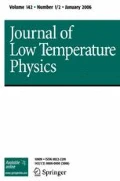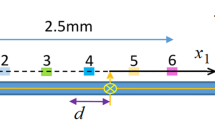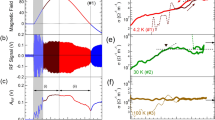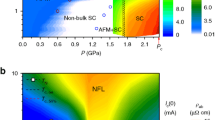Abstract
We have studied the pre- onset deviation-from-linearity region, the transitional regime, and the foot region in the resistance vs temperature behavior of high- Critical Temperature oxide superconductors, employing time-varying magnetic fields and carefully controlled precise temperatures. We have previously shown that the best value of critical temperature can be extrapolated from the magnetic field induced divergence of the resistance vs inverse absolute temperature data as derived from the transitionaland/or foot regions, and that these data are in accord with results from Hall effect studies. The pre-onset region however, shows a differing non -diverging behavior. However sweep magnetic field studies show that, as a function of field, differential resistance data points corresponding to temperature values in the normal state, pre-onset state,and transitional state all lie on a straight line, whereas data points corresponding to the foot region and zero resistance region deviate from this line. We interpret these data to indicate that the phenomena that govern the pre- onset state constitute a different stage of processes that arise initially in the normal state at temperature slightly greater than the critical temperature, and continue in the transitional state at temperature slightly less than the critical temperature. We believe that the lifetime of the particle that mediates Cooper-pairing establishes these different stages of the process leading to superconductivity in the cuprates.
Similar content being viewed by others
References
J. G. Bednorz and R. A. Mueller,Z. Phys. B 64, 189 (1986).
C. W. Chu, R. H. Hor, R. L. Meng, L. Gao, E. J. Huang, and Y. Q. Wang,Phys. Rev. Lett. 58, 405 (1987). C. W. Chu,Phys. Rev. Lett. 58, 1891 (1987).
Jones, T. E.,et al., ACS Symposium Series 377, 1988, pp. 155–167.
B. Brandt, private communication; H. Sample, B. Brandt, and L. Rubin,Rev. Sci. Instrum. 53 (8), 1129 (1982); B. Brandt, L. Rubin, H. Sample,Rev. Sci. Instrum., 59(4),642 (1988).
L. Goldfarb, and D. K. Chen,J. Appl Phys. 63, 400 (1988); J. Ekin, T. M. Larson, N. F. Bergen, A. J. Nelson, A. B. Blankenship,Appl. Phys. Lett. 52 (21), 1819 (1988); J. Ekin A. J. Panson, and B. A. Blankenship,Appl. Phys. Lett. 52(4), 331 (1988).
B. M. Moon,J. Appl. Phys. (in press).
G. C. Vezzoli, M. F. Chen, F. Craver, A. Safari, B. M. Moon, B. Lalevic, T. Burke, and M. Shoga,J. Magn. Mat. 88, 351 (1990).
M. F. Hundley, A. Zettl, A. Stacey, and M. L. Cohen,Phys. Rev. B 35, 8800 (1987). G. C. Vezzoli, T. Burke, B. M. Moon, B. Lalevic, A. Safari, H. G. K. Sundar, R. Bonometti, C. Alexander, C. Rau, and K. Waters.J. Magn. Magn. Mal. 79, 146 (1989), Y. Zhao, J. Xia, Z. He, S. Sun, Q. Zhang, Y. Qian, Z. Chen, and G. Pan,Chin. Phys. Lett. 5, 221 (1988); G. C. Vezzoli, M. F. Chen, F. Craver, and T. Burke, Proc. New York Acad. Sci.,Frontiers in Physics. A. Seshadri,High Temperature Superconductivity, ed. by J. Ashkenazi, S. Barnes, F. Zuo, B. Kline, and G. Vezzoli, Plenum, New York, 1992, p. 225.
G. C. Vezzoli,J. Magn. Mat. 82, 335 (1989);
G. C. Vezzoli, B. M. Moor, M. F. Chen, T. Burke, and F. Craver, In High-Temperature Superconductivity, ed. by J. Ashkenazi, S. E. Barnes, F. Zuo, G. C. Vezzoli and B. M. Klein, Plenum Press, New York, 1991, p. 257–274.
M. B. Maple, Y. Dalichaouch, J. M. Ferreira, R. R. Kake, B. W. Lee, J. J. Neumeier, M. S. Torikachvili, K. N. Kurvz,Physica B 148, 155 (1987);
C. Fincher and G. B. Blanchet,Phys. Rev. Lett. 67 (20), 2902 (1991).
B. Matthies, H. Suhl, and E. Corenzwit,J. Phys. Chem. Solids 13, 156 (1959) andPhys. Rev. Lett. 1, 92 (1958).
J. M. Tarason, L. H. Greene, W. R., McKinnon, G. W. Hull,Solid State Commun. 63, 499 (1987); M. B. Maple, Y. Dalichaousch, J. M. Ferreira, R. R. Hake, B. W. Lew, J. J. Neumeier, M. S. Torikachoili, K. N. Yang, H. Zhou, R. P. Guertin, and M. V. Kuric,Physica B 148, 155 (1987).
B. Lalevic,J. Appl. Phys. 31, 234 (1960) andPhys. Rev. 128, 1070 (1964); R. Weber,Phys. Rev. 72, 1241 (1947); B. Kaplan and J. G. Daunt,Phys. Rev. 89, 907 (1953); D. Baird,Can. J. Phys. 37, 120 (1959), D. H. Andrews, R. M. Mitton, and W. DeSorbo,J. Opt. Soc. Am. 36, 520 (1946) andProc. Roy. Soc. (London)A-82, 194 (1948).
Author information
Authors and Affiliations
Rights and permissions
About this article
Cite this article
Vezzoli, G.C., Chen, M.F. & Burke, T. The pre-onset, transitional, and foot regions in resistance vs temperature behavior in high-critical temperature superconducting cuprates: Inferences regarding maximum critical temperature. J Low Temp Phys 94, 637–645 (1994). https://doi.org/10.1007/BF00753832
Received:
Revised:
Issue Date:
DOI: https://doi.org/10.1007/BF00753832




